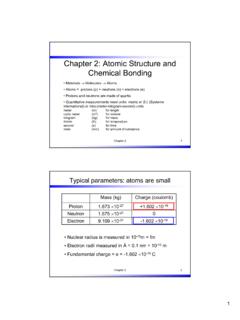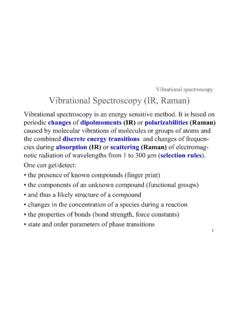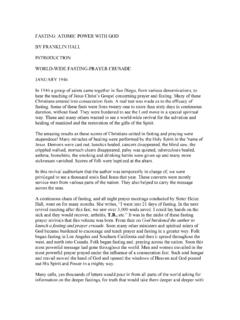Transcription of Chapter 7: Conservation of Mechanical Energy in Spring ...
1 Lecture10: Potential Energy , Momentumand Collisions1 Chapter7: Conservationof MechanicalEnergyin SpringProblemsTheprincipleof conservationof MechanicalEnergycanalsobe appliedto a simplecaseof a masstravelingin a horizontaldirectionat constant a thispoint themasshaszerokineticenergyandthespringh asa maximumof potentialenergy. Ofcourse,thespringwillreboundandthemassw ill nallybe acceleratedto thesamespeedbutoppositein before,andthespringreturnsto a springis compressed(orstretched)a distancexfromitsnormallength,thenthespri ngacquiresa potentialenergyUspring(x):Uspring(x) =12kx2(k=forceconstant of thespring)Worked ExampleA massof given aninitialvelocityvi= , andthencollideswitha springof forceconstantk= 50 Conservationof EnergyInitialMechanicalEnergy=FinalMecha nicalEnergyKi+Ui=Kf+Uf12mv2i+ 0 = 0 +12kx2=)x=vismk= 1:2vuut0:850= 0:152mLecture10: Potential Energy , Momentumand Collisions2 Chapter8: LINEARMOMENTUMandCOLLISIONSThe rstnewphysicalquantity introducedin Chapter8 isLinearMomentumLinearMomentumcanbe de ned rstfora particleandthenfora systemofparticlesor anextendedbody.
2 It is justtheproductof massandvelocity, andis a vectorin thesamedirectionas thevelocity:~p=m~vparticle~P=M~vcmsystem of particles~vcm center-of-massvelocityWhy have thismomentumquantity?In factit was Newtonhimselfwhointro-ducedthequantity in hisversionof Newton' thecaseof aparticleonehas:~F=d~pdt=)~F=d(m~v)dt=md ~vdt=m~aHerewe aremakinguseof thefactthatthemassmof a particledoes madefora systemof particles,or anextendedbody, as longas we always includeallthemass.~Fext=d~Pdt=)~Fext=d(M ~vcm)dt=Md~vcmdt=M~acmConservationof LinearMomentumTheimportant useof LinearMomentumcomesaboutwhenwe considerthespecialcasewhenthereis thatcase,thelefthandsidesof thetwo above ,thelinearmomentumof theparticle,or of thesystemof particles,is 0 =)~p=constantor~pi=~pfFext= 0 =)~P=CONSTANTor~Pi=~PfTHECONSERVATIONOFE NERGYLAWANDTHECONSERVATIONOFMOMENTUMLAWA RETHETWO : Potential Energy , Momentumand Collisions3 EXAMPLEof LINEARMOMENTUMCONSERVATIONO neexampleof linearmomentumconservationinvolves therecoilof a cannon(ora ri e)whena shellis cannonof massM= 3000kg resa shellof massm= 30 kg in velocity of the+^ thevelocity of thevelocity of theshelljustafterit leaves thecannonball?
3 Remember thatwe have thecannonplustheshell,notjustthecannonby itselfof theshellby restheshellisanINTERNAL force,soit thehorizontaldirection,so linearmomentumisconserved in thehorizontaldirection~Pi=~PfTheinitiall inearmomentum~Pi= 0 becausenothingis nallinearmomentum~Pf= 0 also,butit canbe expressedas thesumofthelinearmomenta of thecannonandtheshell:~Pi= 0 =~Pf=M~V+m~vHere~Vis thevelocity of thecannonand~vis thevelocity of ~Vand~varein oppositedirections,and~v= M~Vm=)~v= 3000 1:830^ = 180^ m/sDecay of SubatomicParticlesAnotherexampleof conservationof momentumis thedecay of anisolatedsub-atomicparticlesuch as aneutral kaonwrittensymbolicallyasK0. A neutralkaondecays into two othersubatomicparticlescalledchargedpion s,symbolizedas +and . Thedecay equationis writtenasK0! ++ Byconservationof momentumwe caneasilyprove thatthetwo pionshave.
4 Potential Energy , Momentumand Collisions4 Impulseof a ForceWe de neanothervectorphysicalquantity calledtheImpulseof a thesimplestcase,if a constant forceFactsover a shortperiod of time t,thentheimpulseof thatforceis equalto theproductof theforceandthelengthof timeover which it denotedby thesymbol~J~J=~F t(constant forceF)~J= ~p(isprovedbelow fromNewton'sSecondLawIf theforceis notconstant, thenthede nitionof impulserequiresanintegral~J Z~F(t)dt= ~pTheimpulsecalculationis usefulin determininghow much forceor momentumis involved in violent collisionslastingveryshortperiods of a forceis a usefulvectorquantity fordetermininghow muchforceor momentumis involved in violent collisionslastingveryshortperiods nition,theimpulse~Jis givenas theproductof theaverageforceandthetimeover which theforcewas exerted~J ~F t=)~J=Zt0=t+ tt0=t~FdtHowever,by Newton'sSecondLaw theaverageforcecanbe writtenas:~F= ~p t=)~J= ~p t t= ~pThebookcallsthisequality theImpulse-Linear-Momentum-Theorembutit is justa simpleconsequenceof Newton'sSecondLaw of : Potential Energy , Momentumand Collisions5 Exampleof ImpulseandMomentumCalculationsIn a crashtest,anautomobileof mass1500kgcollideswitha of thecarwasvi= 15m/stotheleft,andthe nalvelocity wasvf= +2:6 m/sto theright.
5 If , \averageforce"meansthatwe aremakinga constant forceapproximationhere(theusualcase)forw hich theimpulseof theforceis:~J ~F t= ~pWe aregiventhetimeduration t= 0:15s, so now we needto ndtherighthandsideof needto nd ~ ~pis thechangein themomentumvectorof nalminus theinitialmomentum ~p=~pf ~piFinally, to calculatetheinitialand nalmomenta we usethede nitionof mo-mentumas theproductof massandvelocity~p m~v~pi=m~vi= (1500kg)( 15:0 m/s)= 22;500kg-m/s~pf=m~vf= (1500kg)(+2:6 m/s)= +3;900kg-m/sTo obtaintheimpulseof theforce,andtheforceitselfwe have:~J= ~p=~pf ~pi= 3;900 ( 22;500)= 26;400kg-m/s~J=~F t= ~p=)~F= ~p t=26;400kg-m/s0:150s= 176;000 NThisforce is 12 timesthecar'sownweight!!Lecture10: Potential Energy , Momentumand Collisions6 CollisionsBetweenTwo IsolatedParticlesConstant MomentumforanIsolatedSystemThepreviousex ampleinvolvedessentiallyjustoneparticle, xedthereas a deviceforexertinga constant studiedwhentwo rstmaketheapproximationthatthetwo factthesearetheactionandthereactionforce swhich we have seenin discussingNewton' canprove thatif two particlesformanisolatedsystemuna ectedby anyotherparticles,thenthevectorsumof themomentumof each particleremainsconstant.
6 We callthevectorsumof thetwo particlemomenta thesystemmomentumP~P ~p1+~p2~P=CONSTANTif therearenoexternalforcesCollisionbetween Two Particlesin anIsolatedSystemWhentwo particlesin anisolatedsystemcollide,thetotalmomentum of thesystemis thesameafterthecollisionas it was theinitialmomentum:m1~v1i+m2~v2i=m1~v1f+ m2~v2f)~p1i+~p2i=~p1f+~p2fThisprincipleo f theconservationof momentumis oneof thestrongestin thereareinternal,frictionalforcesactingw hich decreasethetotalmechanicalenergy, it is nonethelessstilltruethatthetotalmomentum ofan isolated systemat all momentumconservationalsoappliesto an isolatedsystemwhichsuddenlydecomposesint o two or examplea ri e ringa bullet,a cannon ringa rstde netwo basictypesof collisionandthenconsidereach of thesebasictypes in : Potential Energy , Momentumand Collisions7 Two BasicTypes of Two-ParticleCollisionsConservingMomentum Thetypicalsituationin momentumconservationinvolves two particlesin theinitialsystemwithoneor bothof thesehavinga velocity.
7 Thesetwo particlescollidewhereagainonlyinternalfo rcesact,andtheparticlesseparatewithcerta in momentumenablesus to relatethe nalvelocitiesto basictypes of collision:1)ElasticCollisions, and2)InelasticCollisions1)ElasticCollisi onAnelasticcollisionis onein which thetotalkineticenergyof thetwo particlesis thesameafterthecollisionas it was elasticcollisionsarethosebetweenbilliard balls,betweenmassesandsprings,andthosein volvingrubber or ,butalsoonecanwritea kineticenergyconservationequation:m1v1i+ m2v2i=m1v1f+m2v2f(momentumconserved)12m1 v21i+12m2v22i=12m1v21f+12m2v22f(kinetice nergyconserved)Bycombiningthesetwo equationsonecanachieve thegeneralresultthatv1i v2i= (v1f v2f)Therelativevelocityof approachis thenegativeof therelativevelocityof )InelasticandPerfectlyInelasticCollision sIf thereareverystrongfrictionalanddeformati onforces,thenkineticenergywillnolongerbe conservedandinsteadonewillhave aninelasticcollisionis onein which thetwo particlesfuseduringthecollision,andtrave l togetherafterwardswiththesame nalvelocityv1f=v2f vf=)theperfectlyinelasticcollisionm1v1i+ m2v2i=m1vf+m2vf(particleswithsame nalvelocity)=)vf=m1v1i+m2v2im1+m2(perfec tlyinelasticcollision)Lecture10.
8 Potential Energy , Momentumand Collisions8 Exampleof PerfectlyInelasticCollisionA Cadillacwitha massof 1800kg,whilestopped at a tra clight, is rearendedby a Volkswagenwitha massof 900kgtravelingat 20 ,andslideinto theirvelocity afterthecollision?Therelevant equationfora completelyinelasticcollisionisvf=m1v1i+m 2v2im1+m2(perfectlyinelasticcollision)Ta ke theCadillacto bem1, andtheVolkswagento bem2. In thiscasewe havev1i= 0 sovf=m1v1i+m2v2im1+m2=vf=m2v2im1+m2=900 201800+ 900= 6:67m/sWe cancomputethechangein kineticenergyas followsKi=12(m1v21i+m2v22i) =12m2v22i=12(900)(20)2= 180;000 JoulesKf=12(m1v21f+m2v22f) =12(m1+m2)v2f=12(900+1800)(6:67)2= 60;000 Joules K Kf Ki= 60;000 180;000= 120;000 JoulesWhere didall thiskineticenergy go ??Othertypes of perfectlyinelasticcollisionsincludebulle ts redinto blocksofwood afterwhich thebulletis slowed : Potential Energy , Momentumand Collisions9 ElasticCollisionsin OneDimensionTheoppositeextremefroma perfectlyinelasticcollisionis a perfectlyelasticcollisionwherethekinetic energyis equationswithwhich to solve equations(conservationofmomentumandconse rvationof kineticenergy)onecanarrive at a thirdequationwhich givesv1i v2i= (v1f v2f)Therelativevelocityof approachis thenegativeof therelativevelocityof sepa-rationExampleof ElasticCollisionTwo billiardballshave velocitiesof +2:0 and 0:5 m/sbeforetheymeetin ahead{ nalvelocities?}
9 V1i v2i= (v1f v2f)2 ( 0:5) = (v1f v2f) =)v2f= 2:5 +v1fNow substitutethisinto thegeneralconservationof momentumequation,real-izingthatthemasses areidenticalm1v1i+m2v2i=m1v1f+m2v2fv1i+v 2i=v1f+ (1:5 +v1f) = 2v1f+ 1:5+2:0 0:5 = 2v1f+ 2:5v1f= 0:5 m/s;v2f= 2:5 0:5 = 2:0 m/sIn equalmasselasticcollisionsin onedimension, equalmass,onedimensionalelasticcollision swiththe rstparticleat rest,thesecondparticlestopsandthe rstparticlegoesforward withtheoriginalvelocityof number of usefulequationsinvolvingelasticcollision sin specialsituationsin don'thave to memorizethese,buttheycouldbeusefulin ,studytheexamplesof two{ : Potential Energy , Momentumand Collisions10 Two DimensionalCollisionsCollisionsbetweenob jectscanalsooccurin two two particles,m1andm2initiallytravelingtowar dseach otherona straightlinewithvelocities~vi1and~vi2 Thisdirectionis withvelocity components in boththexandtheydirectionsgiven by velocities~v1fand~v2fThebasicprinciplein two dimensionalcollisionsis thesameas in onedimensionalcollisions.}
10 InitialMomentum= FinalMomentumm1~vi1+m2~vi2=m1~v1f+m2~v2f ElasticTwo DimensionalCollisionsA typicaltwo-dimensionalcollisioninvolves particlem1travelingat knownspeedv1hittingparticlem2which is initiallyat o at velocity~v1fwhich is at anangle withrespectto o at velocity~v2fwhich is at anangle withrespectto cannow writetheconservationof momentumequationas follows:X componentm1vi1=m1v1fcos +m2v2fcos Y component0 =m1v1fsin +m2v2fsin If theinitialspeedvi1is known,thentherearefourunknownsin therighthandside:v1f,v2f, , and . Equivalently, each nalvelocity vectorhastwocomponents,so have onlytwo equations,thismeansthatthereis needmoreequations! If thecollisionis elastic,thenwe knowthatthekineticenergybeforeis equalto thekineticenergyafterthecollision12m1v2i 1=12m1v21f+12m2v22fSothatmeanswe cansolve theproblemif we specifyonemoreof : Potential Energy , Momentumand Collisions11 Exampleof ElasticTwo DimensionalCollisionsAsanexampleof a two dimensionalcollision)we consideroneprotontravelingat knownspeed(3:5 105m/s)collidingelasticallywitha secondprotoninitiallyat ,oneprotonmoves o at an angle of 37owithrespectto thetwo protonsafterthecollisionandwhatis theangleof thevelocity of thesecondprotonafterthecollision?








